Shoot Your Own Thanksgiving Turkey
November 12, 2006 -- Reprinted from the Bolex Reporter
(Fall 1960) [1]
Obviously, you can take the title-wording two ways. We're willing to bet,
though, you know what is meant. It's simple enough: build an interesting,
well-paced movie around such a seasonal event as the preparation and serving
of the Thanksgiving turkey.
If you have never made movies indoors before, there are a few simple things to consider before you start running Tom Turkey around the local butcher's shop.
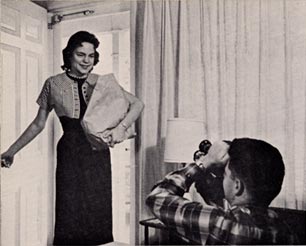
Nowadays, shooting color film indoors is as easy as shooting under bright sunlight. But, because most lights (and you will need a light or two) give off more red (warmer) light than normal daylight color film is balanced for, you will be far better off using a film balanced for tungsten light.
Lights, too, must come into the picture of your thinking in order NOT to come into the picture you make. Most movie makers already own a simple bar-light capable of handling from two to four photofloods or reflector-floods. If you can swing the investment for one additional lamp unit (either a clamp-model or a floor-stand mounted affair), you'll improve your pictures one hundred percent. Even if you cannot, consider the possibility of removing your camera from the bar light, let some eager helper hold it off to one side while you shoot. This'll give your pictures more depth, and the subjects will look far more natural.
If you have white or off-white walls in your living room, kitchen and dining room, you may want to use bounce-lighting, i.e., floods placed to bounce their light output either from the walls or the ceiling. This is, by far, the easiest way to film. You'll probably have to position the lights only once in each room, after which you can move around freely and shoot from whatever angle appeals to you.
Follow the manufacturer's recommendations on exposure and correction filters. At the same time, no printed instruction sheet ever can replace a quality exposure meter used in combination with common sense.
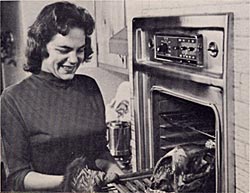
You can plan to build your film around a couple - perhaps a young couple having their first Thanksgiving dinner together - as we did for this article. Or you may want to make one about a family with children; a family with non-related guests; or the family and relatives all gathered around the dining table.
If you choose a young couple alone, they probably will be a little too engrossed in each other, and cooking the first bird, to have worried too much about house decorations. But if there are decorations, open your film here.
A medium shot of the spouse looking at a calendar can be followed by a close-up of a pencil circling the date. Lap-dissolve to the wife arranging the decorations or waving goodbye as she departs for the local super market. Lap-dissolve again to her returning, her arms loaded with groceries.
From here, let your conscience and film supply be your guide. Get shots of her preparing the bird, mixing the stuffing, and placing the whole thing into the oven.
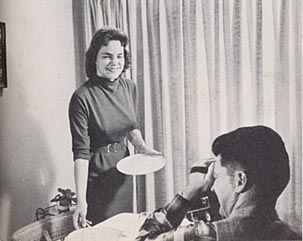
At this point, you will need another transition, since it takes time for the bird to become a culinary delight. As a suggestion, have her look at her watch as she closes the oven door. Then cut to a bold close-up of the watch showing the time. With your Bolex, this isn't difficult at all. If you are filming with an H-16 RX or H-16 Rex, the through-the-lens focusing is made to order for you. You may want to slip a Series V closeup lens over your Switar 25mm to fill the frame with the watch-face.
With non-reflex Bolexes, simply add the close-up lenses or attachments, and compensate for parallax.
End this scene with a fade-out, made either with your variable shutter, or the aperture ring or an iris vignetter. Then let the wife manhandle the camera, and have her fade in on you sitting in the living room, watching television, or engaged in some other pastime. While the camera is running, look at your watch. Follow this with a bold close-up shot just like in the earlier scene, making sure that the two watches show enough elapsed time to account for the turkey's cooking.
Then, back to the oven to pull the succulent bird from its roasting place. Don't overlook scenes of the table being set, you carving the bird as the little woman tries to equal your efforts behind the camera, and lots of close-ups of full plates, happy faces chewing contentedly, steaming coffee cups and the like.
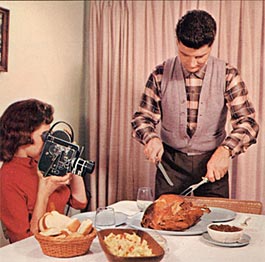
Include a medium shot of the man of the house pushing himself away from the table, heaving a big sigh of content as he loosens his belt.
Lap-dissolve this into a close-up of whatever after-dinner activity you may have in mind - the television set, the record player, a pair of hands dealing a round of bridge, etc. Cut, move or dolly from this to a long-shot of the overall scene. Our couple simply stretched out to relax and watch "the tube!"
Your subjects also might be engaged in putting the youngsters to bed or bidding the guests and/or relatives goodbye. Whatever it is, it's a good "finis" shot for your film - and even better if you can fade out the end.
This isn't as difficult as it sounds, even though you want everyone in the picture. Of course, if there's a spare person around who can close your Bolex's variable shutter, so much the better. If not, try this:
Place your Bolex on a tripod and tell your actors what you want from them. Also, pre-arrange to be near the electrical outlet into which your photofloods and regular room lights are plugged. Preferably, you'll have two separate cords, one for the photofloods, the other for the room lights. Place the cords so that you can reach them with one of your hands which will be shielded from the camera by your body, another person, or furniture.
When everything is set, wind the motor spring of your Bolex fully, and lock the release in its "continuous run" position. Quickly now, take your place, count to "7" slowly, then unplug first the photofloods and then the room lights in quick succession.
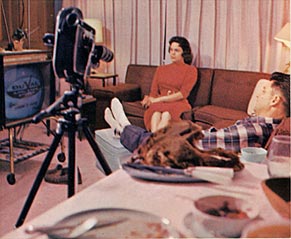
Let the camera run down (unless you know your setup well enough to reach and turn it off in the dark). Then, when the film comes back from the processor, simply edit out the part showing you running from camera to chair, and the finished product will look like a direct cut from a closeup of the activity to a long shot of the overall scene, you included. This, too, shall simply "go black" as the lights are extinguished. Of course, once you kill the photofloods, the film immediately will become underexposed and pick up a deep reddish cast. Then as you unplug the room lights, all illumination will be gone and you'll have an effective fade-out.
This can be stretched out over a longer period of time if you can coach and rehearse your colleagues to unplug one photoflood at a time, in a prearranged sequence, on set signals. If you use this method, kill the so-called "main light" first; then the other lights in succession.
We guarantee that following these simple guides and adding a little of your own imagination along the way for spice, you too, can shoot your own turkey, and eat it, too!
1 This article was originally written by Dan Pendenglasser, III, and appeared in the Fall 1960 issue of the Bolex Reporter magazine (Volume 10, Number 4).

